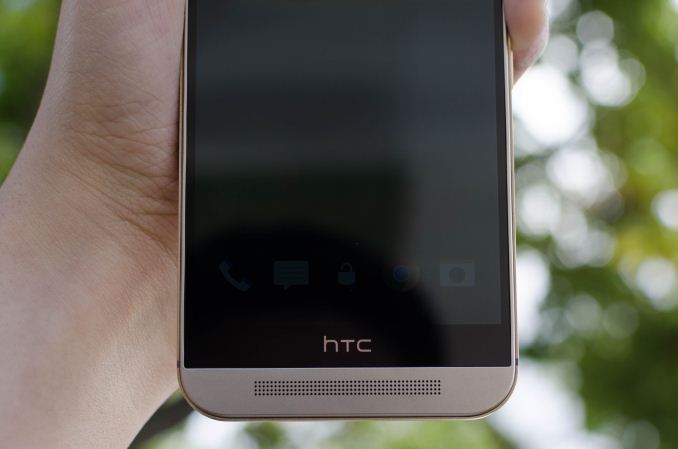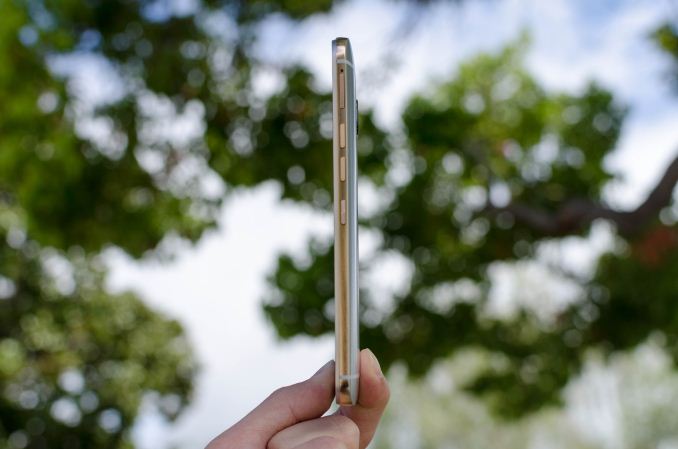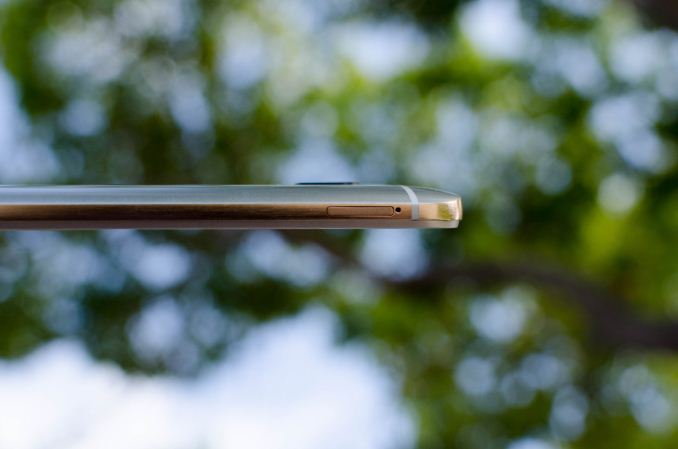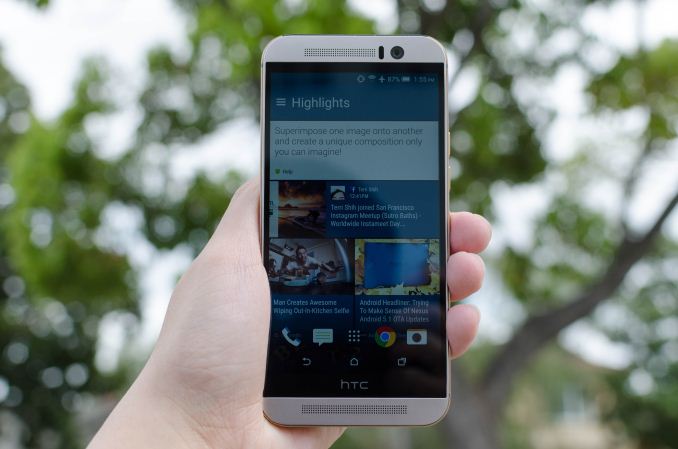The HTC One M9 Review: Part 2
by Joshua Ho on April 6, 2015 10:00 AM EST- Posted in
- Smartphones
- HTC
- Qualcomm
- Mobile
- Snapdragon 810
- One M9
Final Words
Now that we finally have all of the pieces together, we can come to some proper conclusions about the HTC One M9. For those that haven’t read part one of this review, it’s really necessary to do so to understand the context in which these comments are made.
There’s a lot to talk about here, so we’ll start with the design of the phone. HTC is probably the company best-known for design in the Android space, and with the One M9 it seems that they hope to capitalize on this by electing not to significantly change the design.
However, there are a few key changes to the One M9’s design when comparing it to the One M8. For instance, the One M9 moves the power button to the right side of the phone, changes the finish of the back cover, squares off the back cover, and replaces the front plastic bezel with a new plastic bezel. All of these changes seem to make some sort of sense at first, but they almost feel like a regression in some ways. The power button is on the side, but it takes a lot of effort to press it when the phone is held normally in the hand. However, it’s conveniently placed to accidentally press when picking the phone up from a table.
Meanwhile the back cover has a new finish and a neat dual-anodized color, but I question the value of these changes when they reduce yield and drive cost up, especially when sand-blasted anodized aluminum is comparable in look and feel. The continued use of the plastic bezel on the front also cheapens the feel of the phone. The new hard edges on the back cover is also quite uncomfortable, especially when compared to the M8’s smoother curve. There is also the issue of the “logo bar” bezel, but it’s physically impossible to get rid of this bezel due to engineering constraints.
The next aspect worth examining is the display. To HTC’s credit, a 1080p display at 5 inches is the right tradeoff to make with an RGB-stripe display. However, it’s concerning to see significant regressions in almost every area when comparing the display to the M8. An amazing display is almost a requirement for flagship smartphones at this point, and to see such a poor display with equally poor calibration is disappointing. It was clear in the past that HTC genuinely cared about delivering an amazing display, but somewhere along the way it seems that they forgot. We can speculate about the reasons behind this, but this is something that HTC has to fix if they want to remain relevant in the smartphone space, just like every other OEM at this point.
The other critical point of a smartphone is its ability to remain mobile. Battery life is probably the most important aspect of any smartphone, and a poor showing here can be enough to write off a phone. HTC has traditionally done quite well here despite using a smaller battery in their phones than average. Unfortunately, this isn’t true of the One M9. Despite using a newer SoC and a bigger battery, HTC regresses significantly in battery life when compared to the One M8. Although it seems that MIPI command mode has been removed from the One M9, it’s likely that most of the increased power draw can be directly attributed to the SoC, as the impact of panel self-refresh is relatively small.
Speaking of the SoC, the Snapdragon 810’s performance does generally provide a decent improvement over the Snapdragon 805, but it’s relatively little due to HTC’s governor settings which make it quite difficult to reach the maximum 2 GHz state. GPU performance is better than what we see on the Galaxy S6, but this is due to HTC’s choice to stay at a lower native resolution. At the same resolution, the Exynos 7420’s Mali T760 GPU is faster due to higher clock speeds. It’s also disappointing that HTC continues to use benchmark optimizations. The difference in performance is so small at this point that HTC should seriously consider removing these optimizations altogether, as it isn’t worth getting delisted from multiple benchmarks.
The camera of the One M9 is also a weak point, despite significant changes on HTC’s part in this area. Unfortunately, the post-processing here is just not acceptable, and the results of the camera are equally unacceptable. We will have to see how the camera performs without HTC’s heavy-handed post-processing when they update the camera to shoot in RAW, but HTC needs to improve dramatically here for next year.
The one positive note here is Sense 7, which continues to be one of the best experiences in Android overall. I fundamentally disagree with the assertion that a user should go to the Play Store to find various applications that they like, as taking this to its logical conclusion basically ends with having to download a dialer application from the Play Store on first boot. Blinkfeed continues to be a solid application for news, social media, and other information, and HTC’s apps in general are a strong point of differentiation judging by the demand from users to port them to non-HTC phones. However, I still think that HTC didn’t do enough for this iteration of Sense. Most of the applications still feel like they mesh best with Android 4.4, and overall the UI needs to be redesigned to fit with Material Design.
Overall, further testing of the One M9 basically confirms my fears, which were that the One M9 is effectively a sidegrade of the One M8 at best. I really did want to like this phone, as I still find the One M7 to be a great phone to use. I really wanted to see a phone from HTC that was worthy of an upgrade from the One M7, but the One M9 isn’t that phone. In fact, given that the One M8 is at least 200 dollars cheaper than the One M9 on contract, I find it incredibly difficult to recommend the One M9. It will definitely have its fans, but overall there are more negatives than positives. Given the competitive positioning of the One M9, the timing of the Snapdragon 810, and the strength of the Galaxy S6 I’m faced with an intense sense of déjà vu. It almost feels like we’re back where we started 3 years ago with the Sensation and Galaxy S2. I can't think of a better way to describe the situation HTC is in, which is alarming to say the least. The One M9 can't be another Sensation, but it feels like it is.














127 Comments
View All Comments
blanarahul - Tuesday, April 7, 2015 - link
This will be a big problem going forward. Look at Mali T760MP6 on Exynos 5433. Going from 600 MHz to 700 MHz requires a tremendous amount of power. The GHz race could only work till 28 NM it seems. The only solution to improve performance/watt is to go wider.TylerGrunter - Tuesday, April 7, 2015 - link
I can't completely agree with your statement. The issue is that to go to 20nm they should have used FinFet to reduce the current leakage at high frequencies. They didn't (neither GF, Samsung or TSMC) and that has been the consequence: 20nm doesn't scale well at high frequencies.Intel has managed to clock cores till 3.5 GHz already in 14nm FinFet, so with FinFet there shouldn't have the same issue.
By the way: I suspect NVidia had the same issue with the Denver cores and therefore they decided to go with A57 at 20nm.
But I agree that in most of the cases they should go wider (or increase IPC in some other way) in mobile. Even the A57 has only 3 paths.
Frenetic Pony - Tuesday, April 7, 2015 - link
Sure, but apparently finfet is harder for everyone that's not Intel. But Samsung, GloFo, and TSMC all now have Finfet up and running. At 3 years behind Intel for a similar enough feature density, and considering how hard Intel found shrinking their feature size once again, one wonders how long it will take these other 3 to get to a new process node after this. > 2 years is my guess.Alternate materials with less voltage leak and higher electron mobility are really, really needed and I don't understand why more isn't invested into them, other than uninformed executives making the decisions for future investment rather than engineers. 10nm (as in 2 actual feature size shrinks from 22/20nm) is doable with optical tools. But beyond that there are multiple new tools and techniques that need to fight vastly increasing complications and quality needed. The end of Moore's law is indeed within sight.
frenchy_2001 - Tuesday, April 7, 2015 - link
10nm is actually really hard.Either you do quad patterning (write 4 times slightly offset), which is less than trivial (you cannot make each step too wide and you will chip at it to prepare before the next) or you jump to extreme UV, and no one is there yet.
Intel has been spending a lot of time and money in solving those problems for years and they are STILL not solved...
KiretoX - Monday, April 6, 2015 - link
Page 2 table, M9 read camera... OV4688... not Toshiba?Andrei Frumusanu - Monday, April 6, 2015 - link
Fixed the table, thank you.Darkito - Monday, April 6, 2015 - link
RIP HTCnathanddrews - Monday, April 6, 2015 - link
Rip in peace, HTC.blanarahul - Tuesday, April 7, 2015 - link
Dafuq?!Armourcore9brker - Monday, April 6, 2015 - link
You should try setting the camera the way that was done in this XDA thread: http://forum.xda-developers.com/showpost.php?p=598...It seems like setting the ISO too high is causing a lot of the problems.